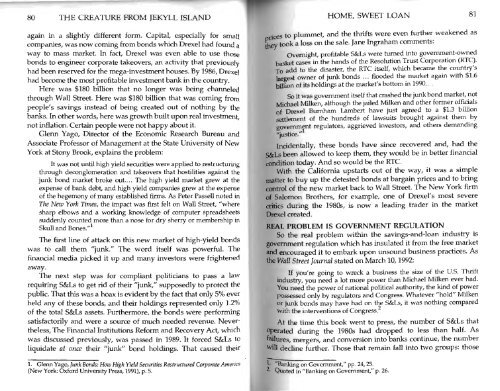You also want an ePaper? Increase the reach of your titles
YUMPU automatically turns print PDFs into web optimized ePapers that Google loves.
.<br />
80 THE CREATURE FROM JEKYLL ISLAND<br />
"<br />
again in a slightly different form. Capital, especially for small<br />
companies, was now corning from bonds which Drexel had found a<br />
way to mass market. In fact, Drexel was even able to use those<br />
bonds to engineer corporate takeovers, an activity that previously<br />
had been reserved for the mega-investment houses. By 1986, Drexel<br />
had become the most profitable investment bank in the country.<br />
Here was $180 billion that no longer was being channeled<br />
through Wall Street. Here was $180 billion that was coming from<br />
people's savings instead of being created out of nothing by the<br />
banks. In other words, here was growth built upon real investment,<br />
not inflation. Certain people were not happy about it.<br />
Glenn Yago, Director of the Economic Research Bureau and<br />
Associate Professor of Management at the State University of New<br />
York at Stony Brook, explains the problem:<br />
It was not until high yield securities were applied to restructuring<br />
through deconglomeration and takeovers that hostilities against the<br />
junk bond market broke out.... The high yield market grew at the<br />
expense of bank debt, and high yield companies grew at the expense<br />
of the hegemony of many established firms. As Peter Passell noted in<br />
The New York Times, the impact was first felt on Wall Street, "where<br />
sharp elbows and a working knowledge of computer spreadsheets<br />
suddenly counted more than a nose for dry sherry or membership in<br />
Skull and Bones." 1<br />
The first line of attack on this new market of high-yield bonds<br />
was to call them "junk." The word itself was powerful. The<br />
financial media picked it up and many investors were frightened<br />
away.<br />
The next step was for compliant politicians to pass a law<br />
requiring S&Ls to get rid of their "junk/' supposedly to protect the<br />
public. That this was a hoax is evident by the fact that only 5% ever<br />
held any of these bonds, and their holdings represented only 1.2%<br />
of the total S&Ls assets. Furthermore, the bonds were performing<br />
satisfactorily and were a source of much needed revenue. Nevertheless,<br />
The Financial Institutions Reform and Recovery Act, which<br />
was discussed previously, was passed in 1989. It forced S&Ls to<br />
liquidate at once their "junk" bond holdings. That caused their<br />
HOME, SWEET LOAN 81<br />
rices to plummet, and the thrifts were even further weakened as<br />
jL>y took a loss on the sale. Jane Ingraham comments:<br />
Overnight, profitable S&Ls were turned into government-owned<br />
basket cases in the hands of the Resolution Trust Corporation (RTC).<br />
t add to the disaster, the RTC itself, which became the country's<br />
largest owner of junk bonds ... flooded the market again with $1.6<br />
billion of its holdings at the market's bottom in 1990.. .<br />
So it was government itself that crashed the junk bond market, not<br />
Michael Milken, although the jailed Milken and other former officials<br />
of Drexel Burnham Lambert have just agreed to a $1.3 billion<br />
settlement of the hundreds of lawsuits brought against them by<br />
government regulators, aggrieved investors, and others demanding<br />
"justice." 1<br />
Incidentally,<br />
these bonds have since recovered and, had the<br />
S&Ls been allowed to keep them, they would be in better financial<br />
condition today. And so would be the RTC.<br />
With the California upstarts out of the way, it was a simple<br />
matter to buy up the detested bonds at bargain prices and to bring<br />
control of the new market back to Wall Street. The New York firm<br />
of Salomon Brothers, for example, one of Drexel's most severe<br />
critics during the 1980s, is now a leading trader in the market<br />
Drexel created.<br />
REAL PROBLEM IS GOVERNMENT REGULATION<br />
So the real problem within the savings-and-loan industry is<br />
government regulation which has insulated it from the free market<br />
and encouraged it to embark upon unsound business practices. As<br />
the Wall Street Journal stated on March 10, 1992:<br />
If<br />
you're going to wreck a business the size of the U.S. Thrift<br />
industry, you need a lot more power than Michael Milken ever had.<br />
You need the power of national political authority, the kind of power<br />
possessed only by regulators and Congress. Whatever "hold" Milken<br />
or junk bonds may have had on the S&Ls, it was nothing compared<br />
with the interventions of Congress.<br />
At the time this book went to press, the number of S&Ls that<br />
operated during the 1980s had dropped to less than half. As<br />
failures, mergers, and conversion into banks continue, the number<br />
w iU decline further. Those that remain fall into two groups: those<br />
1. Glenn Yago, Junk Bonds: How High Yield Securities Restructured Corporate America<br />
(New York: Oxford University Press, 1991), p. 5.<br />
1-<br />
'"Banking on Government/' pp. 24, 25.<br />
-<br />
Quoted in "Banking on Government," p. 26.


